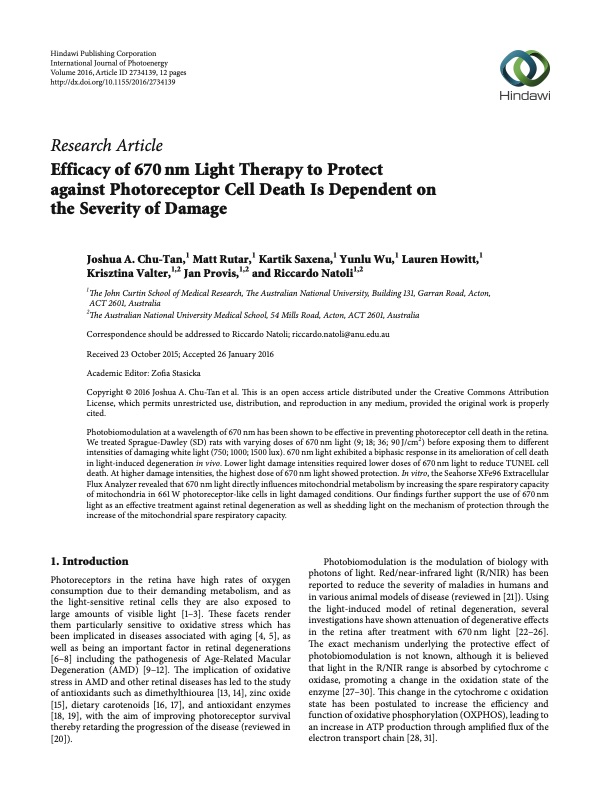
PDF Publication Title:
Text from PDF Page: 002
Hindawi Publishing Corporation International Journal of Photoenergy Volume 2016, Article ID 2734139, 12 pages http://dx.doi.org/10.1155/2016/2734139 Research Article Efficacy of 670 nm Light Therapy to Protect against Photoreceptor Cell Death Is Dependent on the Severity of Damage Joshua A. Chu-Tan,1 Matt Rutar,1 Kartik Saxena,1 Yunlu Wu,1 Lauren Howitt,1 Krisztina Valter,1,2 Jan Provis,1,2 and Riccardo Natoli1,2 1 The John Curtin School of Medical Research, The Australian National University, Building 131, Garran Road, Acton, ACT 2601, Australia 2The Australian National University Medical School, 54 Mills Road, Acton, ACT 2601, Australia Correspondence should be addressed to Riccardo Natoli; riccardo.natoli@anu.edu.au Received 23 October 2015; Accepted 26 January 2016 Academic Editor: Zofia Stasicka Copyright © 2016 Joshua A. Chu-Tan et al. This is an open access article distributed under the Creative Commons Attribution License, which permits unrestricted use, distribution, and reproduction in any medium, provided the original work is properly cited. Photobiomodulation at a wavelength of 670 nm has been shown to be effective in preventing photoreceptor cell death in the retina. We treated Sprague-Dawley (SD) rats with varying doses of 670 nm light (9; 18; 36; 90 J/cm2) before exposing them to different intensities of damaging white light (750; 1000; 1500 lux). 670 nm light exhibited a biphasic response in its amelioration of cell death in light-induced degeneration in vivo. Lower light damage intensities required lower doses of 670 nm light to reduce TUNEL cell death. At higher damage intensities, the highest dose of 670 nm light showed protection. In vitro, the Seahorse XFe96 Extracellular Flux Analyzer revealed that 670 nm light directly influences mitochondrial metabolism by increasing the spare respiratory capacity of mitochondria in 661 W photoreceptor-like cells in light damaged conditions. Our findings further support the use of 670 nm light as an effective treatment against retinal degeneration as well as shedding light on the mechanism of protection through the increase of the mitochondrial spare respiratory capacity. 1. Introduction Photoreceptors in the retina have high rates of oxygen consumption due to their demanding metabolism, and as the light-sensitive retinal cells they are also exposed to large amounts of visible light [1–3]. These facets render them particularly sensitive to oxidative stress which has been implicated in diseases associated with aging [4, 5], as well as being an important factor in retinal degenerations [6–8] including the pathogenesis of Age-Related Macular Degeneration (AMD) [9–12]. The implication of oxidative stress in AMD and other retinal diseases has led to the study of antioxidants such as dimethylthiourea [13, 14], zinc oxide [15], dietary carotenoids [16, 17], and antioxidant enzymes [18, 19], with the aim of improving photoreceptor survival thereby retarding the progression of the disease (reviewed in [20]). Photobiomodulation is the modulation of biology with photons of light. Red/near-infrared light (R/NIR) has been reported to reduce the severity of maladies in humans and in various animal models of disease (reviewed in [21]). Using the light-induced model of retinal degeneration, several investigations have shown attenuation of degenerative effects in the retina after treatment with 670nm light [22–26]. The exact mechanism underlying the protective effect of photobiomodulation is not known, although it is believed that light in the R/NIR range is absorbed by cytochrome c oxidase, promoting a change in the oxidation state of the enzyme [27–30]. This change in the cytochrome c oxidation state has been postulated to increase the efficiency and function of oxidative phosphorylation (OXPHOS), leading to an increase in ATP production through amplified flux of the electron transport chain [28, 31].PDF Image | 670 nm Light Therapy to Protect vs Photoreceptor Cell Death

PDF Search Title:
670 nm Light Therapy to Protect vs Photoreceptor Cell DeathOriginal File Name Searched:
Efficacy_of_670_nm_Light_Therapy_to_Protect_agains.pdfDIY PDF Search: Google It | Yahoo | Bing
Cruise Ship Reviews | Luxury Resort | Jet | Yacht | and Travel Tech More Info
Cruising Review Topics and Articles More Info
Software based on Filemaker for the travel industry More Info
The Burgenstock Resort: Reviews on CruisingReview website... More Info
Resort Reviews: World Class resorts... More Info
The Riffelalp Resort: Reviews on CruisingReview website... More Info
| CONTACT TEL: 608-238-6001 Email: greg@cruisingreview.com | RSS | AMP |